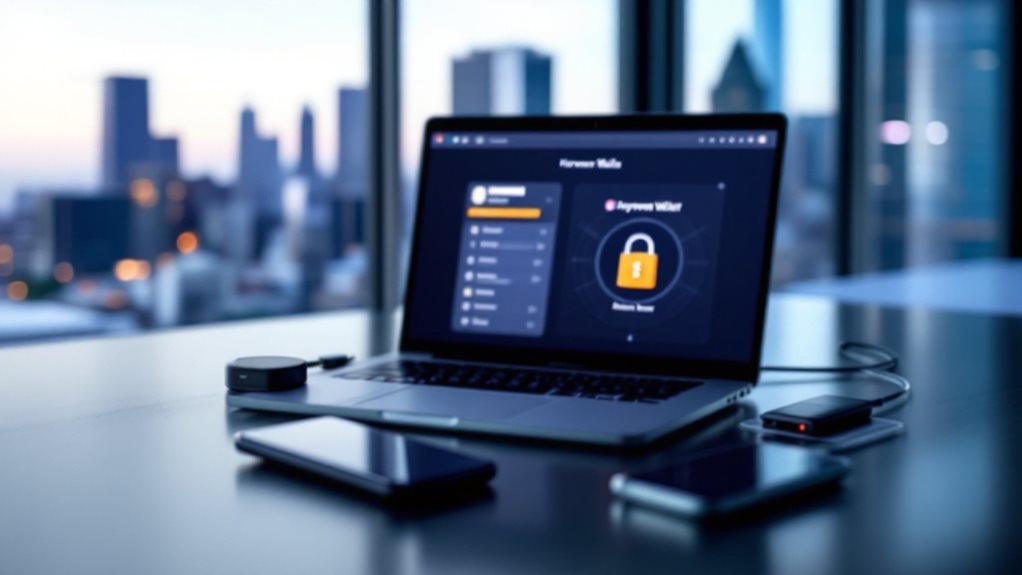Getting a crypto wallet starts with choosing between hot wallets (software-based) or cold wallets (hardware devices). Hot wallets connect to the internet and work well for frequent trading, while cold wallets store crypto offline for better security. Users can download software wallets directly to their devices or purchase hardware wallets from manufacturers. The setup process includes creating passwords, enabling two-factor authentication, and safely storing recovery phrases. There's much more to learn about wallet security and features.

Getting started with cryptocurrency requires a secure digital wallet to store, send, and receive digital assets. The first step is choosing between different types of wallets based on individual needs. Hot wallets are software-based and stay connected to the internet, making them convenient for frequent transactions. Cold wallets are physical hardware devices that store crypto offline, providing enhanced security. Users can also pick between custodial wallets, where a third party manages the private keys, or non-custodial wallets, where users maintain full control of their keys. Mobile wallets offer convenient access but are considered hot storage solutions due to their constant internet connectivity. Popular wallet Coinbase provides intuitive interface layouts for beginners to easily manage their cryptocurrencies.
When selecting a specific wallet, it's important to research reputable providers and check if they support the desired cryptocurrencies. The wallet's user interface should be easy to navigate, especially for newcomers to crypto. Many users check online reviews and the wallet's security history before making their choice. Some wallets offer additional features like built-in exchanges, which can be useful for trading cryptocurrencies. Popular hardware wallets typically cost between 100 to 200 dollars for basic models. These wallets function as blockchain access tools rather than physically storing the cryptocurrency itself.
Setting up a crypto wallet involves several steps that vary depending on the chosen type. For software wallets, users download the application and either create a new wallet or import an existing one. Hardware wallets require purchasing a physical device first. During setup, the wallet generates a recovery phrase that's vital for accessing funds if the wallet is lost or damaged. Users typically set up strong passwords and enable two-factor authentication for extra security. They'll also need to verify their wallet address to confirm they can receive crypto correctly.
The final phase focuses on security measures and proper wallet usage. Recovery phrases and private keys should be stored offline in a secure location, never digitally. Users need to keep their wallet software updated with the latest security patches. It's recommended to use wallets only on devices that are free from malware and other security threats. Many users start with small test transactions to verify everything works correctly before moving larger amounts. Learning how to properly send and receive crypto is fundamental for avoiding costly mistakes.
Crypto wallets come with varying levels of security and convenience. Hot wallets offer quick access but are more vulnerable to online threats. Cold wallets provide better security but aren't as convenient for frequent trading. Non-custodial wallets give users complete control but require more responsibility in keeping keys safe. Custodial wallets are easier to use but require trusting a third party. The choice ultimately depends on how the wallet will be used and the user's security preferences.
Frequently Asked Questions
What Happens to My Crypto if I Lose My Wallet's Private Key?
If someone loses their crypto wallet's private key, they can't access their cryptocurrency anymore.
It's like losing the only key to a safe – there's no backup or master key. The funds stay locked in the blockchain forever.
They can't be recovered by anyone, including the wallet's owner. There's no help desk or authority that can reset or recover lost private keys.
Can I Store Different Types of Cryptocurrency in One Wallet?
Yes, crypto users can store different types of cryptocurrencies in a single wallet.
These are called multi-cryptocurrency wallets. Popular options like Exodus, Ledger, and Trust Wallet can hold hundreds or even thousands of different cryptocurrencies at once.
They're like digital backpacks that can carry Bitcoin, Ethereum, and many other crypto assets together.
These wallets often include features that let users track prices and swap between different cryptocurrencies easily.
Are Crypto Wallets Completely Safe From Hackers?
No crypto wallet is completely safe from hackers.
While hardware wallets (offline storage devices) offer better security than online software wallets, there's always some level of risk.
Hackers can target wallets through malware, phishing scams, or public Wi-Fi networks.
Even major cryptocurrency exchanges have experienced security breaches.
That's why many crypto users spread their assets across different wallet types and use security features like two-factor authentication.
How Much Does It Cost to Maintain a Crypto Wallet?
The cost of maintaining a crypto wallet varies widely.
Software and web wallets are often free, while hardware wallets have a one-time cost of $50-$200.
Users typically pay transaction fees, which range from $1-$5 for Bitcoin and can go higher for Ethereum.
Custom wallet development is expensive, costing $30,000-$300,000 plus yearly maintenance fees.
Most regular users only need to worry about transaction fees and any initial hardware costs.
Can I Transfer Crypto Between Different Types of Wallets?
Yes, crypto can be transferred between different types of wallets. Hot wallets, cold wallets, and paper wallets can all send and receive cryptocurrency from each other.
It's similar to sending money between bank accounts, but users need the recipient's wallet address. Each transfer might have network fees, and some wallets support multiple cryptocurrencies.
The transfer speed varies depending on the blockchain network and wallet types involved.





